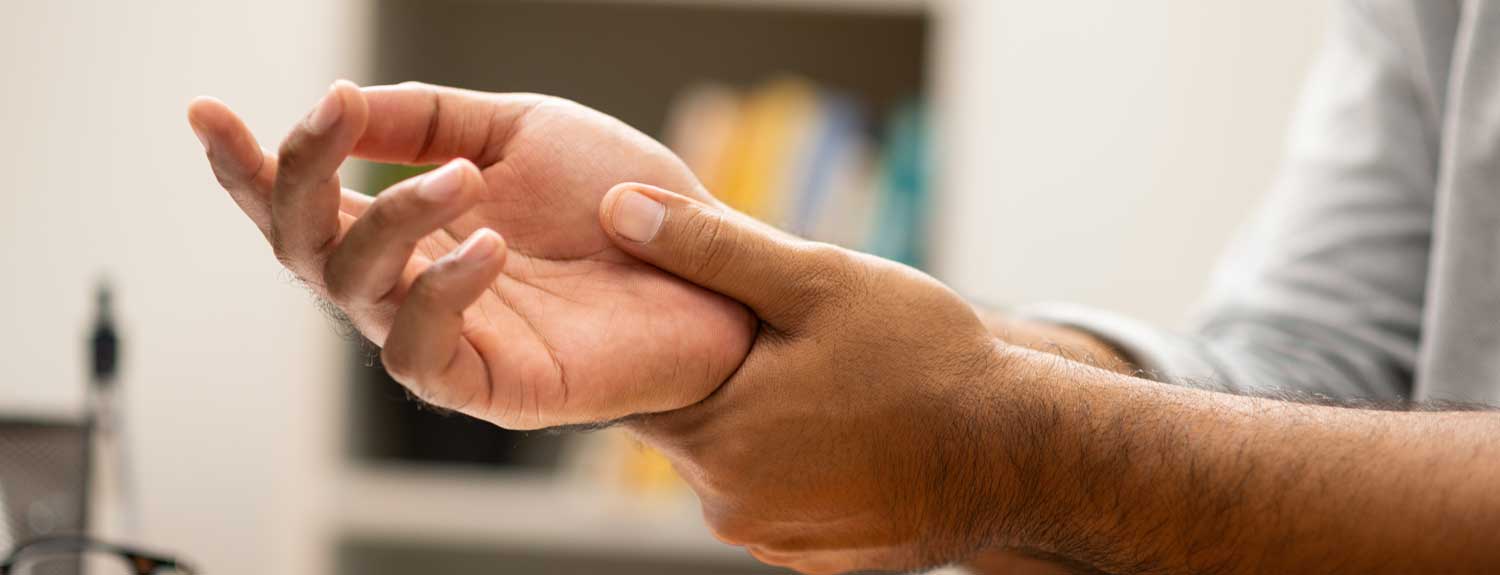email: [email protected]
call: 07494 250277

Carpal Tunnel
Carpal Tunnel Syndrome (CTS)
Carpal tunnel syndrome (CTS) is the most common compression neuropathy of median nerve.
It affects 1 to 10% of people at some time in their life.
The median nerve passes into the hand through a tight space in the wrist, known as the carpal tunnel. This tunnel is bound by a “U” shaped collection of bones straddled by a tight ligament. In CTS the median nerve becomes squashed in the tunnel causing symptoms of tingling in the outer fingers of the hand and thumb. These symptoms are worse after certain activities and typically at night.
If left untreated the nerve can gradually wither causing permanent loss of sensation and wasting of thumb muscles.
CTS has in most cases no known cause but it can be caused by other medical conditions such as Diabetes, Arthritis, thyroid disease, fractures and soft tissue swellings.

What to look for
- A pain in your fingers hands or arm.
- Numbness in the thumb, index and middle finger.
- Tingling or pins and needles.
- Weakness and difficulty with grip.
- Wasting of the muscles at the base of the thumb.
Carpal tunnel symptoms is usually caused by pressure on the nerve at the wrist but sometimes they can develop because of swellings (benign growths) in and around the median nerve such as a traumatic neuroma as shown in this picture.
The Solution
Surgery offers the best chance of short and long term relief compared to other forms of treatment. Surgery for Carpal Tunnel involves cutting the ligament over the tunnel to relieve the pressure on the nerve.
Treatment of Carpal Tunnel
There are a number of ways of treating the condition including activity modification, splinting, anti-inflammatory drugs, steroid injections and surgery.
Surgery is recommended if you have had the problem for a long time, your symptoms are severe, non-surgical treatments have failed or, if the doctor detects wasting of muscles or loss of sensation in the hand.
Surgery offers the best chance of short and long term relief compared to other forms of treatment. Surgery for Carpal Tunnel involves cutting the ligament over the tunnel to relieve the pressure on the nerve.
The operation is usually performed under local anaesthetic and takes 20-30 minutes.
At the end of the operation, the hand will be dressed with a supportive dressing that permits finger movement and light hand use.You will be discharged with specific instructions relating to hand exercises and wound care.
Your stitches will be removed two weeks after your operation. Your pain at night should settle immediately but tingling in the fingers may take some weeks to disappear.
You can drive a car after 2 to 4 weeks as long as you are comfortable and have regained full finger movements. Timing of your return to work is variable according to your occupation and you should discuss this.
There are some risks of CTS surgery which you will need to consider before you agree to proceed:
- Nerve damage: Nerves running in the region can be bruised or damaged during the surgery and form a painful spot in the scar (neuroma) or numbness. The most commonly involved areas are the heel of the hand or the space between the middle and ring fingers. This complication is rare (2%) but may require a further operation to correct.
- Recurrence: If you continue to have attacks of tingling and numbness, it might mean that the ligament has been completely cut or has reformed and tightened This is rare (2%) but the operation would need to be repeated to correct this.
- Infection: Any operation can be followed by infection and this would be treated with antibiotics.
- Scar: You will have a scar on the palm (which sometimes extends a little across the wrist crease). This will be somewhat firm to touch and tender for 6-8 weeks. This can be helped by massaging the area firmly with the moisturizing cream.
- Grip: You will find that your grip is weaker than previously and slightly uncomfortable (“pillar pain”). This will gradually improve over six months.
- Stiffness: About 5% (1 in 20) of people are sensitive to hand surgery and their hand may become swollen, painful and stiff after any operation (algodystrophy). This problem cannot be predicted but will be watched for afterwards and treated with physiotherapy.
- Recovery: Patients who had very numb fingers or wasting of the thumb muscles before surgery will probably never regain full nerve function. Recovery can be very slow (6-12 months). As the nerves grow back, the fingers can actually feel tingly or even unpleasant.
- Nerve damage: Nerves running in the region can be bruised or damaged during the surgery and form a painful spot in the scar (neuroma) or numbness. The most commonly involved areas are the heel of the hand or the space between the middle and ring fingers. This complication is rare (2%) but may require a further operation to correct.
Mr Fitton would be pleased to meet you to discuss your case and to give you more information and advice.
You may also wish to visit the British Society for Surgery of the Hand.







